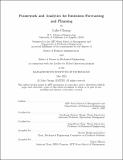Framework and Analytics for Emissions Forecasting and Planning
Author(s)
Chiang, Luke
DownloadThesis PDF (1.287Mb)
Advisor
Zheng, Yanchong (Karen)
Chun, Jung-Hoon
Terms of use
Metadata
Show full item recordAbstract
Amgen has recently committed to achieving 100% carbon neutrality, 40% water reduction, and 75% waste reduction relative to its 2019 baseline by 2027. To help reach these goals, Amgen has taken a science-based approach and has assembled a Sustainability Analytics Team to develop tools based on analytical insights that site leads and executives can use to work towards the 2027 Sustainability Goal. A key business gap identified was the ability to precisely forecast future emissions growth stemming from long term growth of the company.
This thesis presents a methodology to develop a framework that breaks down Amgen's emissions profile and utilizes analytics to understand key emissions drivers for long term growth within a vertical of the framework. The key emissions drivers are then incorporated into an excel model to build upon and supplement Amgen's current forecasting methods. Using the framework and analysis, drug substance (DS) production within the manufacturing vertical in the framework is used as a case study to demonstrate the validity and value of this approach. The initial hypothesis was that increases in DS production will not materially increase Amgen's carbon emissions. Conducting regression analysis on four facilities with DS plants to find correlations between emissions drivers and energy usage revealed that (1) energy usage with respect to DS production was largely insensitive to changes in production volume for sites with large building areas and (2) as DS production intensifies and requires less space, increases or decreases in DS production may materially impact a site's energy usage.
These learnings were incorporated into an excel tool to forecast Amgen's carbon emissions versus current sustainability plans to help executives better understand whether Amgen was on pace to reach carbon neutrality by 2027 despite expected business growth and to make strategic decisions to ensure the sustainability goals are met. Moreover, these learnings can help Amgen prioritize sustainability initiatives that would help meet business needs while limiting or even reducing environmental impact. Examples include but are not limited to increasing cleanroom efficiency to reduce fixed energy usage, debottlenecking current processes before building new plants to limit increases in carbon emissions, and utilizing more energy efficient equipment or processes to reduce variable production energy usage as production intensifies and requires less space.
Beyond helping Amgen reach their sustainability goals, the methodology to developing a framework and conducting analysis can be utilized by all companies in different industries to meet their sustainability goals. The framework and type of analysis can be adjusted for different business activities and needs respectively to develop a holistic model to forecast a company's emissions and drive strategic decisions to minimize environmental impact.
Date issued
2022-05Department
Massachusetts Institute of Technology. Department of Mechanical Engineering; Sloan School of ManagementPublisher
Massachusetts Institute of Technology